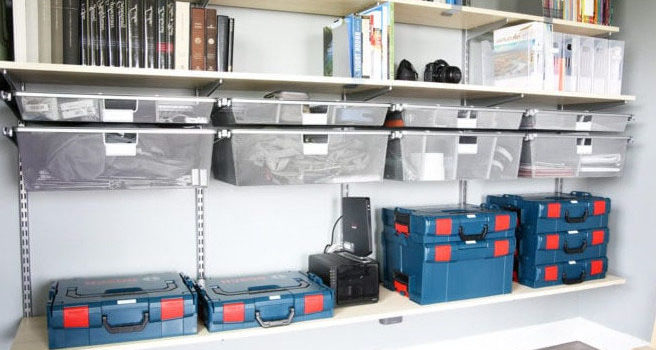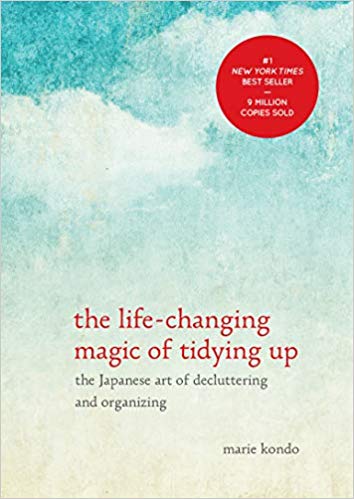

This article is an excerpt from the Shortform summary of "The Life-Changing Magic of Tidying Up" by Marie Kondo. Shortform has the world's best summaries of books you should be reading.
Like this article? Sign up for a free trial here .
After you’ve gotten rid of stuff that doesn’t spark joy, how does Marie Kondo recommend organizing your storage in your home? Learn the top Konmari storage tips here, including how to use her famous boxes, vertical storage, and top things to avoid.
Marie Kondo Tidying, at a High Level
First, let’s review the Konmari method of cleaning and organization to get the right context.
For each category, gather all the items together in a giant pile, discard first, then organize what’s left.
Here’s the correct order of Konmari categories that makes things mentally easier:
- Clothes
- Books
- Papers
- Komono (miscellany)
- Sentimental items
For each category, go through every single item like so:
- Pick it up.
- Ask yourself, does this item spark joy?
- If it does, keep it.
- If it doesn’t, thank it for everything it’s done for you. Then move it to the discard/donate pile.
After you’ve discarded items in a certain category, then you can move on to organizing what’s left in that category. When you organize, keep your storage as simple as possible: use what your home already has, as opposed to buying a lot of complicated storage solutions that ultimately end up cluttering your space more.
Marie Kondo Storage for Each Category
Ideally, you should be able to see everything you own at a glance and get whatever you need easily. Vertical storage is better than horizontal storage to accomplish this, like books upright on a bookshelf instead of stacked on top of each other–it’s much easier to see all your books and take a single book out when they’re organized vertically.
How to Store Things, Marie Kondo’s Way
The more general you are in your sorting, the easier it will be to find what you need.
Since you’ve already discarded according to category, now all you have to do is store those things near each other. Don’t scatter storage throughout your house. Keeping categories together will be the simplest way of keeping track of what you have, accessing what you need where you need it, and not rebounding.
- For instance, many people keep their clothes in a bedroom closet, coats in a different closet, towels and sheets in a linen closet, kitchen towels under the sink–minor separate categories in different places. Then, they have to do mental work to remember where every one of those categories are. This is how we forget what we have–we spread it around our house.
- Instead, organize everything by general type: cloth-like things together, paper-like things together, electrical-like things together. This takes a lot of the stress and mental work out of organizing. Ideally, you could keep your clothes, your coats, and maybe even your sheets and all your towels in a single closet–most likely your bedroom closet–for the easiest general organization. (Shortform note: Wouldn’t this also make putting laundry away much easier?)
The best storage should let you see exactly what you have at a glance, without too much effort. To that end, vertical storage is better than horizontal storage.
- Piles can be endlessly added to–you can always stack more things on top of each other. Infinite storage is bad for organization, and great for clutter. Conversely, vertical storage runs out. You’ll know when you’ve accumulated too much stuff because you won’t have space for it.
- But piling things also puts a lot of strain on the things at the bottom, and will cause them to deteriorate faster. Also, when things end up on the bottom of piles, that’s usually when we stop using them, either because they’re harder to get to, or because they don’t spark joy and we use them less frequently, so they ended up there.
We’ll talk more about storage for each category later, but here’s what vertical storage looks like for clothes. When you pull out a drawer, items are shown vertically, so you can see all the items at once:

Avoid Alternative Storage
Don’t turn to alternative storage solutions–extra sets of drawers, tiered shelving units, containers that open up into many smaller drawers and containers. If you need additional storage options, you probably haven’t discarded successfully. Complicated things won’t help you out in the long run, they’ll just make it more difficult to access what you need and assess how much you have.
Most storage fixes are hideaways for belongings we don’t need.
- A lot of storage just moves the mess around. It might look prettier, but your space is still cluttered, just with storage solutions instead of individual objects.
- What happens once your storage solutions get full? You just buy more storage options or stuff spills out into other areas.
You don’t need anything fancy, and you usually don’t need to buy anything. Cabinets, closets, drawers, and boxes or similar containers are your friend.
- Kondo’s fond of shoeboxes. Use the bigger bottom part to divide your underwear from your socks. Use the thinner top in your kitchen drawers to keep your utensils from sliding all over the place. Use them in the bathroom to organize shampoos. Use them in the kitchen to organize spices or grains or snacks.
- (Shortform note: If you don’t have shoe boxes, try going to a local shoe store and seeing if they have empty ones you can take for free.)
- Other good boxes for organizing smaller items are business card boxes and Apple boxes for phones and music players.
- Items that take up a lot of floorspace can be put in your closet instead of out in space.
- If you have a big, open closet without much internal organization, you can get storage units that go inside the closet. Even things as simple as bookshelves can be put in your closet to help you maximize what gets stored in there.
Don’t buy storage options before you’ve finished going through the whole process. Use all your available space first and then you’ll know exactly what you still need.
Family Household Storage
If there are multiple people in your home, each person should organize their own stuff by category first. Then you can tackle shared stuff in communal spaces.
If you do have multiple members in a household, make sure everyone has…
———End of Preview———

Like what you just read? Read the rest of the world's best summary of Marie Kondo's "The Life-Changing Magic of Tidying Up" at Shortform . Learn the book's critical concepts in 20 minutes or less .
Here's what you'll find in our full Marie Kondo summary :
- The psychological benefits of tidying
- How to Tidy the Konmari method
- How to deal with Clothing, Books, Papers, and Sentimental Items
- ...and much more





![Stoicism: A Good Life Philosophy 8 Secrets to Living a Good Life [Charlie Munger]](https://www.shortform.com/blog/wp-content/uploads/2021/06/good-life-morning-coffee-270x270.jpg)

Packing, moving, and organizing your stuff is the challenging way for first-time storage unit owners. These tips are really helpful. Thank you for sharing it.